Dans des industries comme exploitation minière, pétrole et gaz, construction, and manufacturing, pièces d'usure en carbure de tungstène are vital for keeping equipment running efficiently.
These parts face extreme pressure, high temperatures, and constant friction. While standard parts are available, many companies require custom designs to meet unique operational needs.
Customizing wear parts allows businesses to improve performance, reduce downtime, and lower replacement costs.
This guide explains how to customize tungsten carbide wear parts, including design tips and industry standards every decision-maker should know.
Pourquoi choisir le carbure de tungstène pour les pièces d'usure
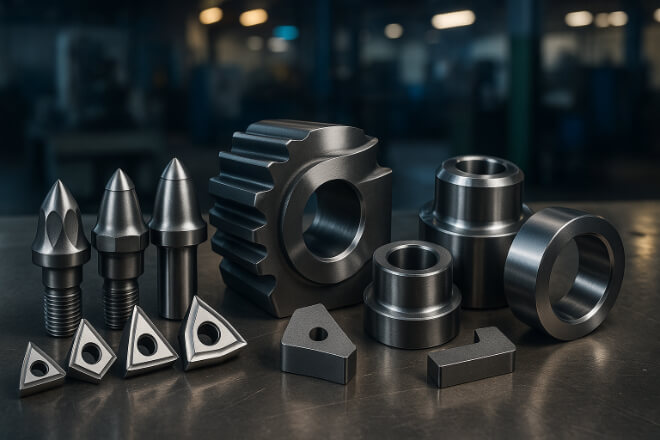
Tungsten carbide is chosen because of its exceptional dureté, dureté, et résistance à l'usure.
Compared to steel, it lasts much longer in harsh environments, making it the preferred material for:
Trépans de forage minier
Cutting tool inserts
Composants de pompe et de vanne
Industrial dies and punches
Key Benefits of Tungsten Carbide Wear Parts:
Longer service life than steel or ceramics.
Resistance to wear, heat, and corrosion.
High strength even under extreme loads.
The Importance of Customization
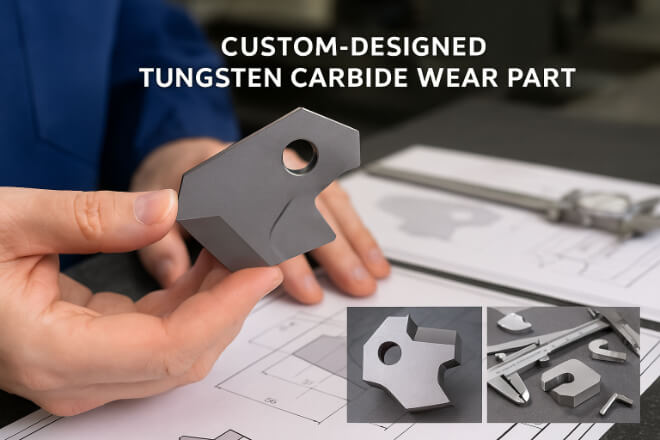
Standard tungsten carbide parts may not always fit a machine’s exact needs. Customization ensures:
The part fits perfectly within existing systems.
The material grade matches the operating conditions.
The design improves efficiency and reduces energy use.
Customization can involve size adjustments, geometry changes, surface coatings, or special tolerances.
Factors to Consider When Designing Custom Tungsten Carbide Wear Parts
When designing custom wear parts, several factors must be balanced to achieve optimal performance.
a) Material Grade Selection
Tungsten carbide grades vary in dureté, dureté, and binder content. Choosing the right grade is critical for your application.
| Type de note | Idéal pour |
|---|---|
| High Hardness (Low Binder) | Abrasive environments where wear is the main issue. |
| High Toughness (High Binder) | High-impact applications like mining picks or crushers. |
| Balanced Grade | General industrial use with mixed wear and impact conditions. |
b) Dimensional Tolerances
Custom parts must match precise tolerances to ensure a perfect fit. Poor tolerances can cause:
Misalignment
Premature wear
Equipment failure
Grinding and finishing processes help achieve micron-level accuracy.
c) Surface Finish
A smoother surface finish can reduce friction and heat buildup, improving part life.
Coatings like TiN, TiAlN, or diamond can also be applied for extra protection.
d) Shape and Geometry
Complex shapes can improve performance. For example:
Curved cutting edges reduce vibration.
Special grooves help with material removal.
Tapered edges improve penetration.
Industry Standards for Tungsten Carbide Wear Parts
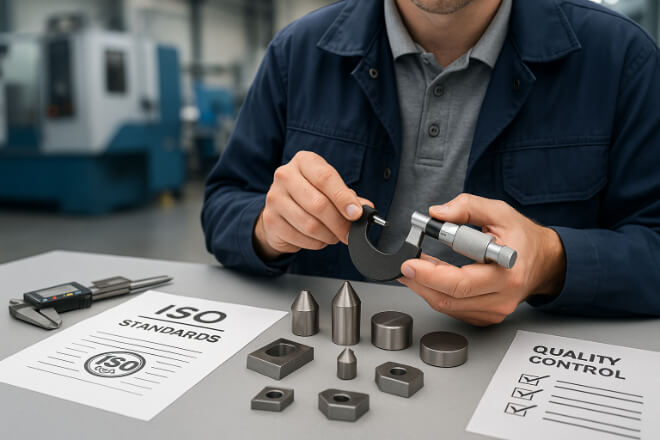
Custom designs must still meet recognized manufacturing and quality standards to ensure reliability.
Common Standards:
ISO 513 — classification and application of cutting tool materials.
ANSI/ASME standards — dimensional and performance requirements.
ASTM B777 — tungsten-based material specifications.
ISO 3327 — hardness testing of sintered metals.
Meeting these standards ensures:
Consistent quality across batches.
Compatibility with other industry parts.
Safety and reliability during operation.
Working with a Manufacturer
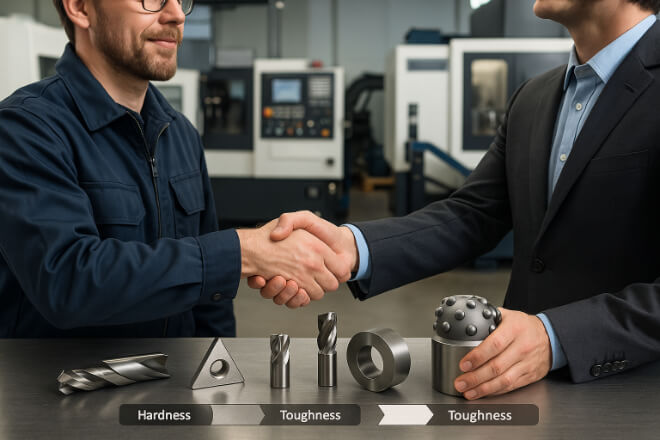
Choosing the right manufacturing partner is as important as the design itself.
What to Look For in a Supplier:
Experience with tungsten carbide manufacturing.
In-house engineering support for design optimization.
Advanced equipment for sintering, grinding, and coating.
Strong quality control processes.
Communication Tip:
Provide detailed drawings, operating conditions, and performance expectations to help the manufacturer produce the right part.
Cost Considerations in Customizing Wear Parts
Custom tungsten carbide parts can cost more upfront than standard ones, but they often deliver better long-term savings.
Factors Affecting Cost:
| Facteur | Impact on Cost |
|---|---|
| Qualité du matériau | Higher toughness or specialty coatings increase cost. |
| Complexity of Shape | Intricate geometries require more grinding and machining time. |
| Production Volume | Larger orders reduce unit cost. |
| Type de revêtement | Advanced coatings like diamond are more expensive. |
Design Tips for Longer Wear Part Life
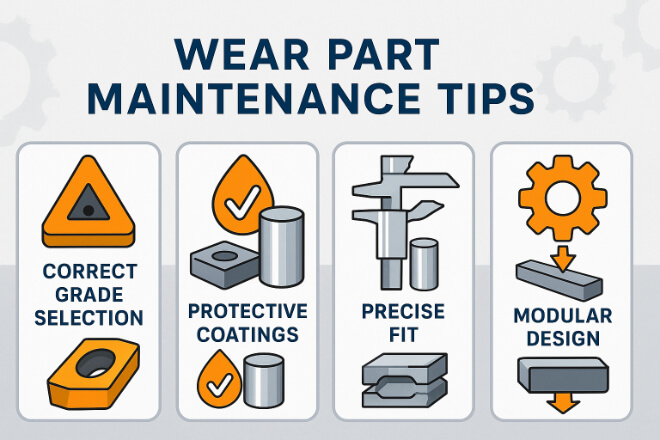
Match carbide grade to application (don’t over-specify hardness for impact-heavy jobs).
Use coatings to protect against corrosion or extreme heat.
Ensure precise fit to avoid stress points.
Design easy-to-replace components to reduce downtime.
The ROI of Custom Tungsten Carbide Wear Parts
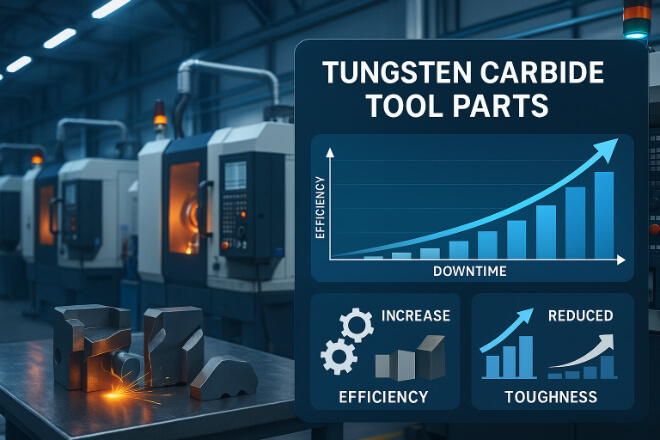
For decision-makers, the main reason to invest in customization is return on investment (ROI).
By using parts that last longer and perform better, companies can:
Reduce maintenance costs.
Minimize machine downtime.
Improve production efficiency.
In some cases, a well-designed custom part can last 5–10 times longer than a standard steel part.
Conclusion
Customizing tungsten carbide wear parts is not just about making a part fit—it’s about optimizing performance, reducing costs, and extending service life.
By following proper design tips and meeting industry standards, businesses can ensure they get the maximum value from their investment.
For decision-makers, understanding these principles means smarter purchasing decisions and stronger long-term performance from equipment.
Si vous souhaitez en savoir plus sur une entreprise, n'hésitez pas à Contactez-nous.
